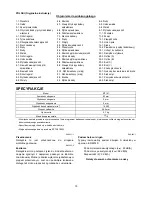
8
planing. Planing will be easier if you incline the workpiece
in stationary fashion, so that you can plane somewhat
downhill.
The speed and depth of cut determine the kind of finish.
The power planer keeps cutting at a speed that will not
result in jamming by chips. For rough cutting, the depth of
cut can be increased, while for a good finish you should
reduce the depth of cut and advance the tool more
slowly.
Shiplapping (Rabbeting)
Fig.12
To make a stepped cut as shown in the figure, use the
edge fence (guide rule).
Fig.13
Draw a cutting line on the workpiece. Insert the edge
fence into the hole in the front of the tool. Align the blade
edge with the cutting line.
Fig.14
Adjust the edge fence until it comes in contact with the
side of the workpiece, then secure it by tightening the
screw.
Fig.15
When planing, move the tool with the edge fence flush
with the side of the workpiece. Otherwise uneven planing
may result.
Maximum shiplapping (rabbeting) depth is 9 mm.
Fig.16
You may wish to add to the length of the fence by
attaching an extra piece of wood. Convenient holes are
provided in the fence for this purpose, and also for
attaching an extension guide (optional accessory).
NOTE:
The shape of the guide rule is differ from country to
country. In some country, the guide rule is not included as
a standard accessory.
Chamfering
Fig.17
Fig.18
To make a chamfering cut as shown in the figure, align
the "V" groove in the front base with the edge of the
workpiece and plane it.
MAINTENANCE
CAUTION:
•
Always be sure that the tool is switched off and
unplugged before attempting to perform inspection
or maintenance.
•
Never use gasoline, benzine, thinner, alcohol or the
like. Discoloration, deformation or cracks may
result.
Sharpening the planer blades
For conventional blades only
Fig.19
Always keep your blades sharp for the best performance
possible. Use the sharpening holder (optional accessory)
to remove nicks and produce a fine edge.
Fig.20
First, loosen the two wing nuts on the holder and insert
the blades (A) and (B), so that they contact the sides (C)
and (D). Then tighten the wing nuts.
Fig.21
Immerse the dressing stone in water for 2 or 3 minutes
before sharpening. Hold the holder so that the both
blades contact the dressing stone for simultaneous
sharpening at the same angle.
Replacing carbon brushes
Fig.22
Remove and check the carbon brushes regularly.
Replace when they wear down to the limit mark. Keep
the carbon brushes clean and free to slip in the holders.
Both carbon brushes should be replaced at the same
time. Use only identical carbon brushes.
Fig.23
Use a screwdriver to remove the chip cover or nozzle.
Fig.24
Use a screwdriver to remove the brush holder caps. Take
out the worn carbon brushes, insert the new ones and
secure the brush holder caps.
To maintain product SAFETY and RELIABILITY, repairs,
any other maintenance or adjustment should be
performed by Makita Authorized Service Centers, always
using Makita replacement parts.
Summary of Contents for MT191
Page 11: ...11 11 12 13 14 15 16 17 Makita 18 Fig 1 Fig 2 Fig 3...
Page 12: ...12 Makita Fig 4 Fig 5 Fig 6 Fig 7 1 Fig 8 2 3 4 5 Fig 9 6 7 8 9 10 1 9...
Page 13: ...13 A B B A B A EN0004 1 Fig 10 Makita Fig 11 Fig 12 Fig 13 Fig 14 Fig 15 9 Fig 16...
Page 14: ...14 Fig 17 Fig 18 V Fig 19 Fig 20 D Fig 21 2 3 Fig 22 Fig 23 Fig 24...
Page 48: ...48 Makita Corporation Anjo Aichi Japan www makita com 885032 979...









































